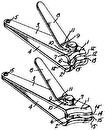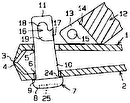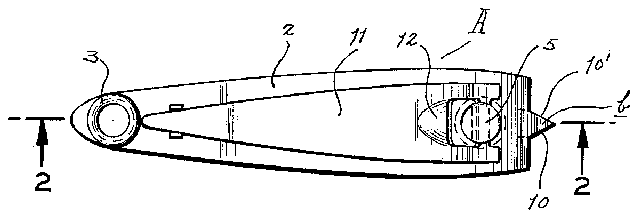
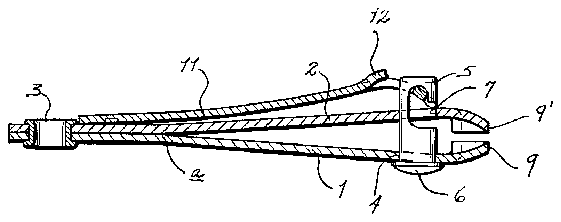
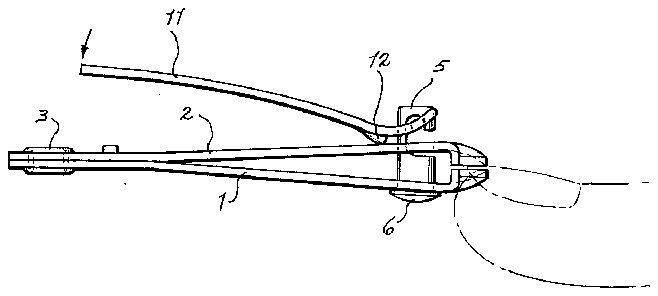
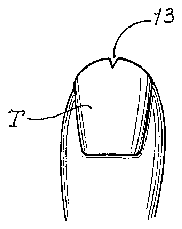
- 1jaws
- 2jaws
- 3rivet
- 4opening
- 5stem
- 6enlarged flanged head
- 7aperture
- 9knife edges
- 11said lever arm
- 13said v-shaped cut
- 18june
- 22line
- 93smith
- 516patent united states patents
- 702patent united states patents
- 898smith
Description
June 18, 1963 K. G. SMITH 3,093,898
NAIL CLIPPERS Filed June 8, 1961 INVENTOR. KENNETH (3. SMITH QaJ A w. E042 ATTORNEY United States This invention relates in general to cutting instruments of the general cutter-nipper character, and, more particularly to certain new and useful improvements in nail clippers.
Ingrown nails, more commonly encountered with :toe nails, which consistently provide a source of pain and discomfort, are caused by the growth of the nails laterally into the adjacent flesh. Limited attention, if any, has been given to procedures or means for preventing the development of ingrown nails, but, inexplicably, there has been a general resignation to ignoring any possible precautionary means and to an acceptance of the curative treatment which requires the surgical cutting away of the portions of the nail which have exceeded the confines of the channels of normal growth.
Therefore, it is an object of the present invention to provide a nail clipper which is designed to effect the removal of a portion of a properly growing nail which will allow the nail to have a growth component inwardly toward its center and thus counter any inherent laterally outward growth to thereby prevent ingrowth within the adjacent flesh.
It is another object of the present invention to provide a nail clipper for the purpose stated which may be easily and effectively utilized by the average individual in an habitual manner, as in customary nail clipping or like acts of personal grooming and hygiene, and without the requiring of any developed skill.
It is an additional object of the present invention to provide a nail clipper of the character stated which may be most economically manufactured, having a simplicity of parts and being amenable to high speed production; which is most durable and reliable in operation; and which may be made in a compact, easily manipulated form.
These and other detailed objects are obtained by the structures illustrated in the accompanying drawing, in which- FIGURE 1 is a top plan view of a nail clippers constructed in accordance with and embodying the present invention.
FIGURE 2 is a vertical transverse sectional view taken on the line 22 of FIGURE 1.
FIGURE 3 is a side view illustrating the clipper in operative position.
FIGURE 4 is a View of a toenail subsequent to clipping by the present invention.
Referring now by reference characters to the drawing which illustrates the preferred embodiment of the present invention, A generally designates a nail clipper comprised of a pair of registering, normally lower and upper jaw members 1, 2 formed of suitable spring steel, which at their outer ends (being the ends remote from a nail being clipped) are in superimposed surface-wise abutment and secured together in such state as by a rivet 3. Spacedly inwardly from said rivet 3, as at a, jaw members 1, 2 are slightly bent downwardly and upwardly, respectively away from each other, for mutual divergence and thereby being urged apart through their inherent bias. Proximate its inner end jaw 1 is drilled to form an opening 4 for extension therethrough of a stem-forming member or pin 5 having an enlarged flanged head 6 against the normally upper surface of which jaw 1 restrainedly abuts. In its normally upper portion, stem member 5 projects freely through an aperture 7, aligned with opening 4, in jaw member 2 so that as jaws l, 2
atent are moved relatively toward and away from each other as will be described hereinbelow, said stem 5 serves to maintain said jaws in registering relationship for effective operational purposes.
At their extreme inward ends jaw members 1, 2 are bent upwardly and downwardly respectively, toward each other, and centrally are formed to provide cooperative, opposed, beveled cutting or knife edges 9, 9, respectively; each edge 9, 9' being formed along converging sides, as 10, 10' of each jaw of a cutting portion indicated at b The apex of said cutting portion b is located preferably along the longitudinal center line of clipper A. Through the bias of jaws 1, 2, the cooperative cutting edges will be urged into parted or open relationship (FIGURE 2) but upon the application of a compressive force jaws 1, 2 will be brought together bringing the knife edges 9, 9 into direct operative relationship so as to cut material received therebetween, such as, particularly, in this instance, the human nail, in conformity with the configuration of cutting portion b.
In order to facilitate the closing of jaws 1, 2 there is swingably mounted on the upper, projecting end of stem 5 a lever arm 11 adapted for movement between inoperative position as shown in FIGURE 2 wherein it may be disposed in overlying relationship upon jaw 2, and raised or operative position, as shown in FIGURE 3, wherein a small projection, as at 12, on said lever arm 11 is brought into engagement with the upper surface of jaw 2, and upon downward pressure upon said lever arm 11, as in the direction of the arrow shown in FIGURE 3, said jaws 1, 2 are easily forced together for clipping operation.
Referring to FIGURE 4, it will be noted that the cooperating knife edges 9, 9 of cutting portion b cause a V-shaped cut, as at 13, extending inwardly from the edge of the materials being operated on, such as, a toenail, as indicated at T, in FIGURE 4. Said V-shaped cut 13, being preferably made in the central portion of the free edge of a toenail produces a space or void, as it were, which reduces the pressure of laterally directed growth components of the toenail and creates an area into which the normally lateral components may be directed. Thus, the V-sliaped cut effected by the use of the present invention reliably prevents a nail from growing into adjacent flesh with expected painful consequences.
It is apparent that the nail clipper of the present invention is a most simple device, which may be cheaply manufactured by well-known, high-volume production techniques; and which may be easily manipulated by an individual for home usage without any previous training.
Furthermore, the present invention provides a positive manner in which the user can reliably avoid the incident of ingrown toenails and can be accordingly spared the discomfort, pain and cost attendant to surgical treatment.
It is understood that changes and modifications in the form, construction, arrangement, and combination of the several parts of the nail clippers may be made and substituted for those herein shown and described. without departing from the nature and principle of the present invention.
Having thus described my invention, what I claim and desire to secure by Letters Patent is:
1. Nail clippers for creating a substantially central outwardly opening indentation in a nail to be clipped for relieving pressure of lateral growth components of the nail, comprising Efi-ISt and second jaws adapted for movement toward and away from each other, said jaws having cooperating, complementary, opposed cutting edge portions provided at one of their ends, said jaws being formed of resilient steel and biased into separated parted relationship at their cutting edge ends, the cutting edges of each of said jaws comprising a pair of lateral portions extending transversely of said jaws and an intermediate portion extending endwise thereof, said intermediate portion of said cutting edges comprising a pair of straight sides in converging relationship.
2. Nail olippers for creating a substantially central outwardly opening indentation in a nail to be clipped for relieving pressure of lateral growth components of the nail comprising first and second jaws adapted for movement forward and away from each other, said jaws being formed of resilient metal, means fixedly engaging said jaws together at one of their end portions, means lbiasing said jaws into separated, parted relationship at their opposite ends, said jaws at their said opposite ends having cooperating, complementary, opposed cutting edges, the cutting edge of each jaw being comprised of a pair of symmetrical lateral portions extending transversely 2- of said jaws, said lateral portions being of equal extent, and an intermediate portion projecting endwise of said jaws beyond the said lateral portions, said intermediate portion having a pair of straight side components in converging relationship for meeting at a point on the longitudinal center line of the clippers spacedly forwardly from said lateral portions.
References Cited in the file of this patent UNITED STATES PATENTS 702,516 Wilcox June 17, 1902 1,702,137 Schnefel Feb. 12, 1929 2,460,522 Miller Feb. 1, 1949 2,515,852 Bils'ky July 18, 1950 2,739,379 Bassett Mar. 27, 1956 2,774,138 Gowdey Dec. 18, 1956



